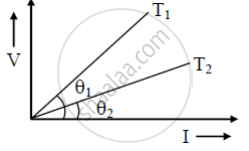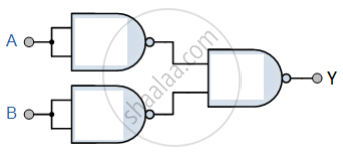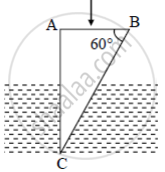Science (English Medium)
Academic Year: 2014-2015
Date: मार्च 2015
Advertisements
- All questions are compulsory. There are 26 questions in all.
- This question paper has five sections: Section A, Section B, Section C, Section D, Section E.
- Section A contains five questions of one mark each. Section B contains five questions of two marks each, Section C contains twelve questions of three marks each, Section D contains one value based question of four marks and Section E contains three questions of five marks each.
- There is no overall choice. However, an internal choice has been provided in one question of two marks, one question of three marks and all the three questions of five marks weightage. You have to attempt only one of the choices in such questions.
What is the function of a bandpass filter used in a modulator for obtaining AM signal?
Chapter: [0.15] Communication Systems
A planar loop of rectangular shape is moved within the region of a uniform magnetic field acting perpendicular to its plane. What is the direction and magnitude of the current induced in it?
Chapter: [0.04] Moving Charges and Magnetism
When light travels from an optically denser medium to a rarer medium, why does the critical angle of incidence depend on the colour of light?
Chapter: [0.09] Ray Optics and Optical Instruments
V-I graph for a metallic wire at two different temperatures T1 and T2 is as shown in the figure. Which of the two temperatures is higher and why?

Chapter: [0.03] Current Electricity
Define the dielectric constant of a medium. What is its S.I unit?
Chapter: [0.02] Electrostatic Potential and Capacitance
Define a wavefront. Using 'Huygens' principle, draw the shape of a refracted wavefront, when a plane wave is incident on a convex lens.
Chapter: [0.1] Wave Optics
When a wave is propagating from a rarer to a denser medium, which characteristic of the wave does not change and why?
Chapter: [0.09] Ray Optics and Optical Instruments
What is the ratio of the velocity of the wave in the two media of refractive indices μ1 and μ2?
Chapter: [0.04] Moving Charges and Magnetism
A variable resistor R is connected across a cell of emf ε and internal resistance r as shown in the figure. Draw a plot showing the variation of
(i) Terminal voltage V and
(ii) the current I, as a function of R.

Chapter: [0.03] Current Electricity
Differentiate between amplitude modulated (AM) and frequency modulated (FM) waves by drawing suitable diagrams. Why is FM signal preferred over AM signal?
Chapter: [0.15] Communication Systems
Determine the distance of the closest approach when an alpha particle of kinetic energy 4.5 MeV strikes a nucleus of Z = 80, stops and reverses its direction.
Chapter: [0.13] Nuclei
When the electron orbiting in hydrogen atom in its ground state moves to the third excited state, show how the de Broglie wavelength associated with it would be affected.
Chapter: [0.12] Atoms
In Young's double-slit experiment, the two slits are separated by a distance of 1.5 mm, and the screen is placed 1 m away from the plane of the slits. A beam of light consisting of two wavelengths of 650 nm and 520 nm is used to obtain interference fringes.
Find the distance of the third bright fringe for λ = 520 nm on the screen from the central maximum.
Chapter: [0.1] Wave Optics
In Young's double-slit experiment, the two slits are separated by a distance of 1.5 mm, and the screen is placed 1 m away from the plane of the slits. A beam of light consisting of two wavelengths of 650 nm and 520 nm is used to obtain interference fringes.
Find the least distance from the central maximum where the bright fringes due to both the wavelengths coincide.
Chapter: [0.1] Wave Optics
Advertisements
The figure shows the plot of binding energy (BE) per nucleon as a function of mass number A. The letters A, B, C, D, and E represent the positions of typical nuclei on the curve. Point out, giving reasons, the two processes (in terms of A, B, C, D, and E ), one of which can occur due to nuclear fission and the other due to nuclear fusion.

Chapter: [0.13] Nuclei
Identify the nature of the radioactive radiations emitted in each step of the decay process given below.
`""_Z^A X -> _Z^A _-1^-4 Y ->_Z^A _-1^-4 W`
Chapter: [0.13] Nuclei
Name the three different modes of propagation in a communication system. State briefly why do the electromagnetic waves with a frequency range from a few MHz up to 30 MHz can reflect back to the earth. What happens when the frequency range exceeds this limit?
Chapter: [0.15] Communication Systems
Define the terms "stopping potential' and 'threshold frequency' in relation to the photoelectric effect. How does one determine these physical quantities using Einstein's equation?
Chapter: [0.11] Dual Nature of Radiation and Matter
Three circuits, each consisting of a switch 'S' and two capacitors, are initially charged, as shown in the figure. After the switch has been closed, in which circuit will the charge on the left-hand capacitor
(i) increase,
(ii) decrease, and
(iii) remains the same? Give reasons.

Chapter: [0.02] Electrostatic Potential and Capacitance
The outputs of two NOT gates are fed to a NOR gate. Draw the logic circuit of the combination of gates. Write its truth table. Identify the gate equivalent to this circuit.
Chapter: [0.14] Semiconductor Electronics - Materials, Devices and Simple Circuits
You are given circuit as shown in the figure, which consists of NAND gate. Identify the logic operation carried out by the two. Write the truth table. Identify the gates equivalent to the tow circuits.

Chapter: [0.14] Semiconductor Electronics - Materials, Devices and Simple Circuits
You are given a circuit as shown in the figure, which consists of the NAND gate. Identify the logic operation carried out by the two. Write the truth table. Identify the gates equivalent to the tow circuit.

Chapter: [0.14] Semiconductor Electronics - Materials, Devices and Simple Circuits
Draw the circuit diagram of a full wave rectifier. Explain its working showing its input and output waveforms.
Chapter: [0.14] Semiconductor Electronics - Materials, Devices and Simple Circuits
Write the property of a junction diode which makes it suitable for rectification of ac voltages.
Chapter: [0.14] Semiconductor Electronics - Materials, Devices and Simple Circuits
A potential difference V is applied across a conductor of length L and diameter D. How is the drift velocity, vd, of charge carriers in the conductor affected when (i) V is halved, (ii) L is doubled and (iii) D is halved ? justify your answer in each case.
Chapter: [0.04] Moving Charges and Magnetism
A cyclotron's oscillator frequency is 10 MHz. What should be the operating magnetic field for accelerating protons? If the radius of its 'dees' is 60 cm, calculate the kinetic energy (in MeV) of the proton beam produced by the accelerator.
Chapter: [0.04] Moving Charges and Magnetism
Deduce the expression for the torque `vec"τ"` acting on a planar loop of area `vec"A"` acting on a planar loop of area `vec"B"`. If the loop is free to rotate, what would be its orientation in stable equilibrium?
Chapter: [0.01] Electric Charges and Fields [0.05] Magnetism and Matter
How are electromagnetic waves produced? What is the source of the energy carried by a propagating electromagnetic wave?
Identify the electromagnetic radiations used
(i) In remote switches of a household electronic device; and
(ii) as a diagnostic tool in medicine
Chapter: [0.08] Electromagnetic Waves
(a) A ray of light is incident normally on the face AB of a right-angled glass prism of refractive index aμg 1.5. The prism is partly immersed in a liquid of an unknown refractive index. Find the value of the refractive index of the liquid so that the ray grazes along the face BC after refraction through the prism.
(b) Trace the path of the rays if it were incident normally on the face AC.

Chapter: [0.1] Wave Optics
Advertisements
Sunita and her friends visited the exhibition. The policeman asked them to pass through a metal detector. Sunita's friends were initially scared of it. Sunita, however, explained to them the purpose and working of the metal detector.
Answer the following questions :
(a) On what principle does a metal detector work?
(b) Why does the detector emit a sound when a person carrying any metallic object walks through it?
(c) State any two qualities which Sunita displayed while explaining the purpose of walking through the detector.
Chapter: [0.03] Current Electricity
State Faraday's laws of electromagnetic induction.
Chapter:
Explain, with the help of a suitable example, how we can show that Lenz's law is a consequence of the principle of conservation of energy.
Chapter: [0.06] Electromagnetic Induction
Use the expression for Lorentz force acting on the charge carriers of a conductor to obtain the expression for the induced emf across the conductor of length l moving with velocity v through a magnetic field B acting perpendicular to its length.
Chapter: [0.07] Alternating Current
Using the phasor diagram, derive the expression for the current flowing in an ideal inductor connected to an a.c. source of voltage, v= vo sin ωt. Hence plot graphs showing the variation of (i) applied voltage and (ii) the current as a function of ωt.
Chapter: [0.07] Alternating Current
Derive an expression for the average power dissipated in a series LCR circuit.
Chapter: [0.07] Alternating Current
State Gauss's law in electrostatics. Show, with the help of a suitable example along with the figure, that the outward flux due to a point charge 'q'. in vacuum within a closed surface, is independent of its size or shape and is given by `q/ε_0`
Chapter: [0.01] Electric Charges and Fields
Two parallel uniformly charged infinite plane sheets, '1' and '2', have charge densities + `sigma and -2sigma `respectively. Give the magnitude and direction of the net electric field at a point.
(i) in between the two sheets and
(ii) outside near the sheet '1'.
Chapter: [0.02] Electrostatic Potential and Capacitance
Define electrostatic potential at a point. Write its S.I. unit. Three-point charges q1, q2 and q3 are kept respectively at points A, B, and C as shown in the figure, Derive the expression for the electrostatic potential energy of the system.

Chapter: [0.02] Electrostatic Potential and Capacitance
Depict the equipotential surface due to
(i) an electric dipole,
(ii) two identical positive charges separated by a distance.
Chapter: [0.02] Electrostatic Potential and Capacitance
A point-object is placed on the principal axis of convex spherical surface of radius of curvature R, which separates the two media of refractive indices n1 and n2 (n2>n1). Draw the ray diagram and deduce the relation between the distance of the object (u), distance of the image (v) and the radius of curvature (R for refraction to take place at the convex spherical surface from rarer to denser medium.
Chapter: [0.09] Ray Optics and Optical Instruments
Use the above relation to obtain the condition on the position of the object and the radius of curvature in terms of n1and n2 when the real image is formed.
Chapter: [0.09] Ray Optics and Optical Instruments
Draw a labelled ray diagram showing the formation of image by a compound microscope in normal adjustment. Derive the expression for its magnifying power.
Chapter: [0.09] Ray Optics and Optical Instruments
How does the resolving power of a microscope change when
(i) the diameter of the objective lens is decreased?
(ii) the wavelength of the incident light is increased ?
Justify your answer in each case.
Chapter: [0.09] Ray Optics and Optical Instruments
Other Solutions
Submit Question Paper
Help us maintain new question papers on Shaalaa.com, so we can continue to help studentsonly jpg, png and pdf files
CBSE previous year question papers Class 12 Physics with solutions 2014 - 2015
Previous year Question paper for CBSE Class 12 Physics-2015 is solved by experts. Solved question papers gives you the chance to check yourself after your mock test.
By referring the question paper Solutions for Physics, you can scale your preparation level and work on your weak areas. It will also help the candidates in developing the time-management skills. Practice makes perfect, and there is no better way to practice than to attempt previous year question paper solutions of CBSE Class 12.
How CBSE Class 12 Question Paper solutions Help Students ?
• Question paper solutions for Physics will helps students to prepare for exam.
• Question paper with answer will boost students confidence in exam time and also give you an idea About the important questions and topics to be prepared for the board exam.
• For finding solution of question papers no need to refer so multiple sources like textbook or guides.
